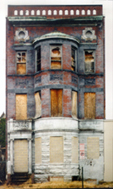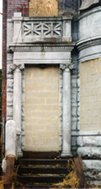E8
C
lick These Thumbnails For Larger High-Resolution Images.
Dr. Martin's Memorial
Today, the blocks immediately east of Mount Vernon Square are lonely without being deserted. At almost any hour, traffic streams up and down New York Avenue past blank-walled warehouses, parking lots, and the towering smokestack of the long-defunct Yale Steam Laundry. Spaces constantly open and close in the ranks of patrol cars outside the police station at the corner of Fifth Street NW. But pedestrians are few and far between in the cleared trapezoidal blocks between New York Avenue and K Street, which could be a village green if they were not paved over and surrounded by chain link fencing.
It's hard to believe that within living memory the essentially houseless 400 block of New York Avenue NW was home to approximately 300 people. What seems unusual in a southern city like early twentieth century Washington is that this was a stable, racially-integrated block. In 1910, approximately 40% of its residents were Black or of "mixed race". Houses seemed to run in short alternating strings of households of each race. Both Black and White households seemed to include skilled tradesmen and service workers, their extended families, and lodgers.
When Dr. Thomas Martin died at home on February 15, 1939, the Washington Evening Star called him "one of the oldest colored physicians practicing here". Born in the District in 1854, Dr. Martin attended city schools and was an early medical graduate of Howard University. For many years he was on staff at Freedmen's Hospital and maintained an office near 18th and L Streets NW. But, as he prospered, Dr. Martin perhaps felt the need to work closer to his home neighborhood around Third Street and New York Avenue NW.
In 1902, he had architect L.F. Stutz file plans for a three story townhouse at 465 New York Avenue NW. Built by John C. Yost for an estimated $ 12,500, Dr. Martin's townhouse compared favorably with those on such fashionable streets as Rhode Island and Massachussetts Avenues. Constructed of brick and cut stone, it had central hot water heat. Its decoration included bas relief panels between the first and second story and top story ventilation ports disguised as garlanded stone wreathes. But perhaps its most impressive features was the three story front bay, suggesting a turret and topped with a faux finial. The entrance, which also gave access to Dr. Martin's first floor office, was highly ornamented with carved stone designs and flanked by Corinthian columns.
Perhaps the only defect of the grand house was that it was lonely, for Dr. Martin, a middle-aged bachelor, married after moving in. He lived and worked there for the rest of his long life, while, over the years, the familiar neighborhood sloughed away. Industrial uses began taking over the east half of Dr. Martin's block in the 1920s, and the smaller neighboring row houses passed through their declining years as stores before being razed one by one.Today Dr. Martin's empty house stands as the only memorial to the neighborhood that once was.

